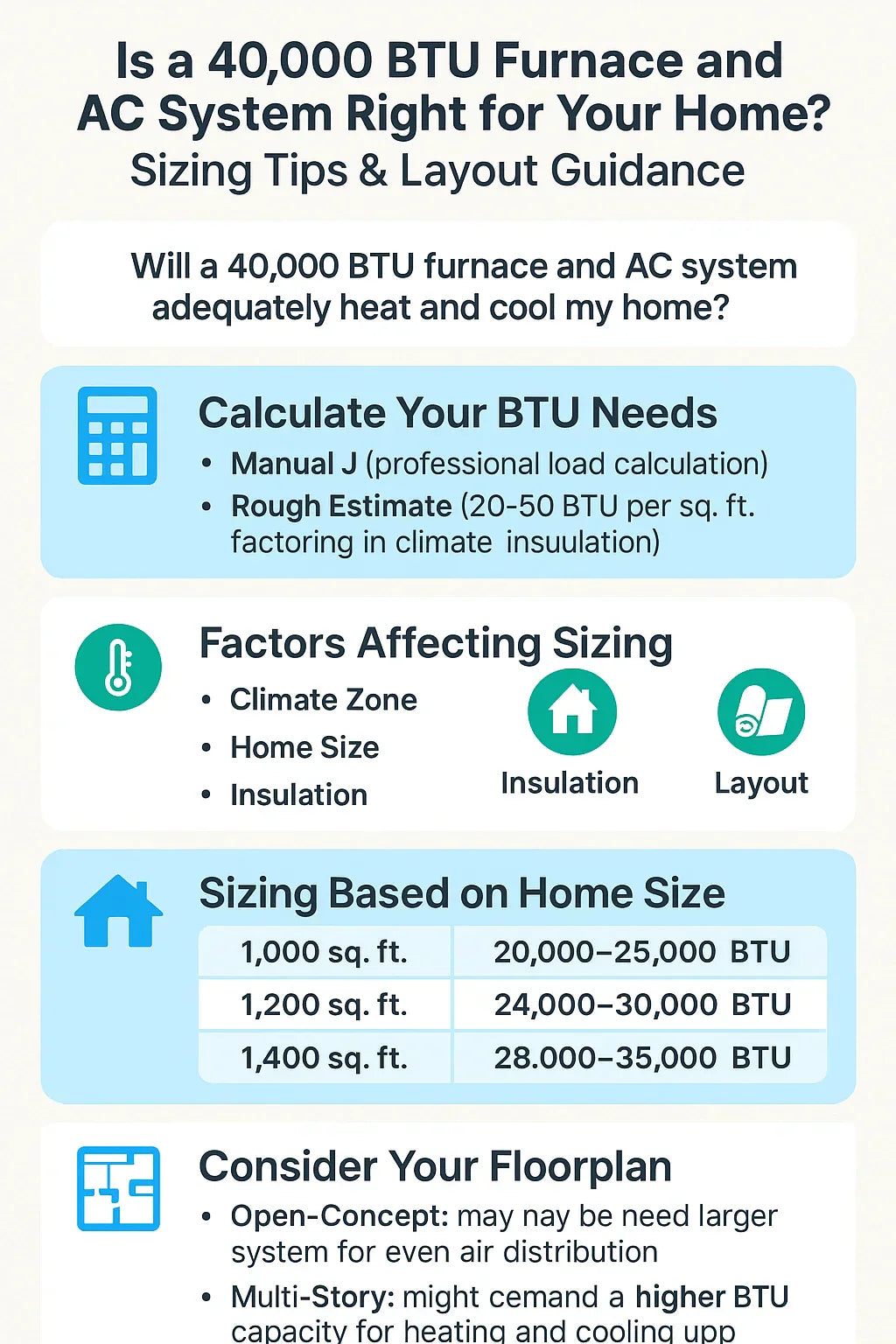Mark Callahan’s Guide to Confidently Choosing the Right System Without Overpaying or Undersizing
📐 Understanding BTU: What It Means and Why It Matters
BTU (British Thermal Unit) measures the heating or cooling capacity of your HVAC system. For homeowners like Mark looking to upgrade or replace a system, understanding BTUs is essential to:
-
Avoiding undersizing (cold spots, system overwork, higher bills).
-
Avoiding oversizing (short cycling, humidity issues, wasted energy).
-
Matching system capacity with your home’s layout and insulation.
Typically, a 40,000 BTU furnace paired with a matched AC system suits homes in the 1,000–1,400 sq. ft. range, depending on climate zone and insulation quality.
🛠️ Quick Rule of Thumb for Estimating BTU Needs
While a Manual J load calculation is ideal for precision, you can use a quick rule:
-
30–35 BTUs per sq. ft. in colder climates.
-
25–30 BTUs per sq. ft. in moderate climates.
-
20–25 BTUs per sq. ft. in warmer climates.
For example, in a moderate climate:
-
A 1,200 sq. ft. home x 25 BTUs = 30,000 BTUs.
-
A 1,400 sq. ft. home x 30 BTUs = 42,000 BTUs.
This places 40,000 BTUs in the sweet spot for many smaller homes, older bungalows, condos, or mobile homes.
🌡️ Climate Zones: How Your Location Impacts Sizing
Your climate zone significantly impacts your heating and cooling needs:
-
Zone 1–2 (South): Lower BTUs needed; a 40,000 BTU system can cover up to 1,500 sq. ft.
-
Zone 3–4 (Midwest): 40,000 BTUs typically suit 1,100–1,400 sq. ft.
-
Zone 5–6 (North): You may only cover 900–1,200 sq. ft. with a 40,000 BTU furnace.
Use the U.S. DOE Climate Zone Map here for reference.
🏚️ Home Insulation and Construction Matter
A well-insulated home with modern windows and minimal leaks will require fewer BTUs than an older, drafty house.
-
Older homes (pre-1980): May need closer to 35 BTUs per sq. ft.
-
Newer homes (post-2000): Often manage with 25–28 BTUs per sq. ft.
If your home has poor insulation, consider upgrades to reduce system size and utility bills. For guidance, see Energy Star’s insulation recommendations for your region.
📊 Using Manual J for Precise Sizing
Manual J load calculations account for:
-
Square footage
-
Ceiling heights
-
Window sizes and orientation
-
Insulation levels
-
Number of occupants
-
Heat-generating appliances
-
Local climate
While you can hire an HVAC professional to run Manual J, you can also use online tools like CoolCalc to perform an accurate load calculation before purchasing your system.
🖼️ Floorplan and Layout Considerations
Beyond square footage, consider:
-
Open vs. compartmentalized layouts: Open plans distribute heat/cool more evenly, while closed layouts may need zoning.
-
Basements: Heated basements reduce heating loads above.
-
Sun exposure: South-facing homes may need less heating.
-
Vaulted ceilings: Increase volume and BTU requirements.
Mark Callahan recommends sketching your floorplan, noting window orientation and insulation levels to share with your HVAC supplier when selecting your system.
🪟 Windows and Air Leakage Impact
Homes with many single-pane windows or significant air leaks lose heat faster. You may need to size up slightly or improve window sealing and insulation before upgrading HVAC.
Use ENERGY STAR’s DIY air sealing guide to reduce air leaks, which could allow you to confidently size at 40,000 BTUs instead of oversizing to compensate for losses.
❓ Signs 40,000 BTUs May Not Be Enough
-
Home exceeds 1,500 sq. ft. in Zone 4+.
-
Poor insulation and drafty windows.
-
High ceilings in multiple rooms.
-
Significant air leakage you cannot address.
In these cases, consider stepping up to a 50,000–60,000 BTU system.
✅ Signs 40,000 BTUs Is a Good Fit
-
Home size under 1,400 sq. ft.
-
Good to moderate insulation.
-
Reasonable ceiling heights (8–9 ft.).
-
You live in Zones 2–4.
-
No plans to significantly add finished space.
🧰 Choosing the Right 40,000 BTU Furnace and AC System
When ready to purchase, consider:
-
AFUE ratings: Higher AFUE means greater efficiency.
-
SEER2 for AC: Higher SEER2 reduces cooling costs.
-
Stage options: Single-stage is budget-friendly, two-stage offers comfort and efficiency.
-
Noise levels: Especially important in small homes and condos.
📝 Conclusion: Sizing for Long-Term Efficiency and Comfort
Choosing a 40,000 BTU furnace and AC system is often ideal for smaller homes when properly matched to your:
-
Square footage.
-
Climate zone.
-
Insulation and air sealing.
-
Layout and ceiling heights.
Mark Callahan’s rule: Don’t oversize or undersize. Instead, use a Manual J calculation or at least a climate zone-based BTU estimate to confirm fit, and upgrade your insulation if your home is borderline.
If you’re ready to explore the right system, browse 40,000 BTU Furnace and AC Systems here or consult with The Furnace Outlet’s support team to confirm compatibility with your home.
In the next topic we will know more about: 40,000 BTU Furnace Efficiency Ratings Explained: AFUE, SEER2, and What They Mean for Your Bills







